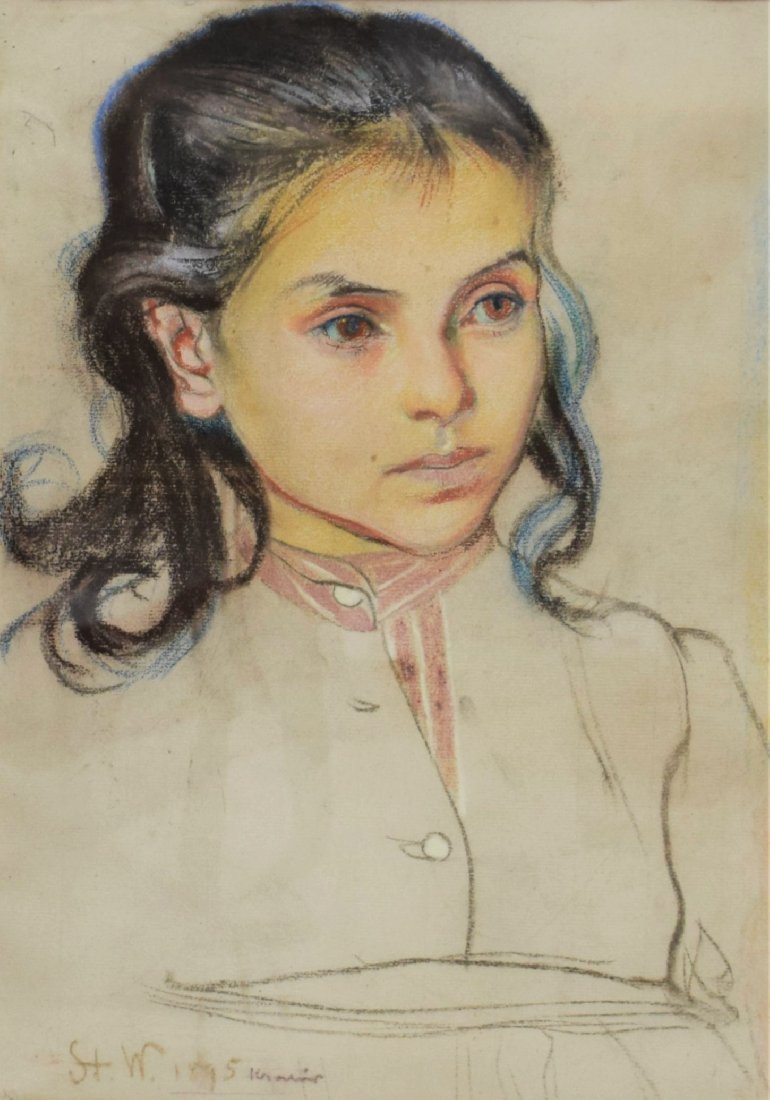Description:
Stanisław Wyspiański (1869-1907). His original and recognizable style was shaped by his studies with Jan Matejko in Krakow, his travels and several years spent in Paris with his friend Józef Mehoffer. He was particularly impressed by the works of Van Gogh, Gauguin and Toulouse Lautrec that he encountered there. As he was allergic to oil paint, he began to use mostly pastels. In addition to painting, he also worked in graphics, created decorative polychromes, designed stained glass windows, theatrical performances, interiors and furniture, wrote poetry and dramas. His art, which fits into the program of Young Poland, is described as symbolic, expressionist and Art Nouveau.
Description of the painting:
The portrait depicts a small, calm figure of a young model. She looks pensive. There is a certain dissonance between her childlike features and the gravity that is painted on her face, emphasized additionally by the hair, which with its ash and blue streaks looks to be graying. Her dress is marked with only a few, but flawless lines, in the recognizable style of Wyspiański.
The extraordinary gaze of bright-brown eyes, silent lips and a small face framed by dark hair, speckled with blue-gray glints create an expression of strange maturity of the portrayed. The serious almond-shaped eyes look to the right, but seem to look more into themselves, as if the model had become thoughtful and distracted, not seeing the surroundings. The expression of the face can find a mixture of different feelings, from sadness, fatigue or exhaustion, through irritation, as well as a kind of prudence or wisdom, not belonging to a girl’s figure.
The yellowish complexion of the face contrasts with the white of the sketchy dress, as well as the clear background. The collar stands out with delicate pink-white stripes, the same color as the lips and shadows around the girl’s eyes. It is surprising to use ash and blue shades for the dark hair, which is styled in a casual, girly hairstyle. Loose strands fall in waves on the shoulders of the model. She sits comfortably, leaning on an invisible chair. Although the dress is marked with only a few lines, the artist marked the detail of one of the buttons popping out of the hole.
The portraits of Wyspiański are distinguished by the combination of his peculiar, linear style with the simultaneous perfect rendition of both the physiognomy of the person portrayed and their state of mind and character. The images, mostly drawn with pastels, are very personal, true and also very characteristic and recognizable. Before he started drawing or painting, he often observed the model for a long time, so that the model started to get impatient, bored or irritated, which is often noticeable in the paintings. He took his art very seriously, no matter what was to come out of his hand.
The portraits of Wyspiański were constantly created among other great projects. His inexhaustible creative force pushed him to be not only a painter or graphic artist, but also an interior designer, furniture maker, theatrical director, stained glass designer, poet and dramatist. He fit perfectly into his era and although today we can describe his art with words: Art Nouveau, symbolism, expressionism, modernism, and Wyspiański as a representative of the Young Poland, he himself never liked to be put into such categorizations. Regardless of these definitions, however, he remains one of the most recognizable and acclaimed artists of the turn of the 19th/20th century in Poland.


